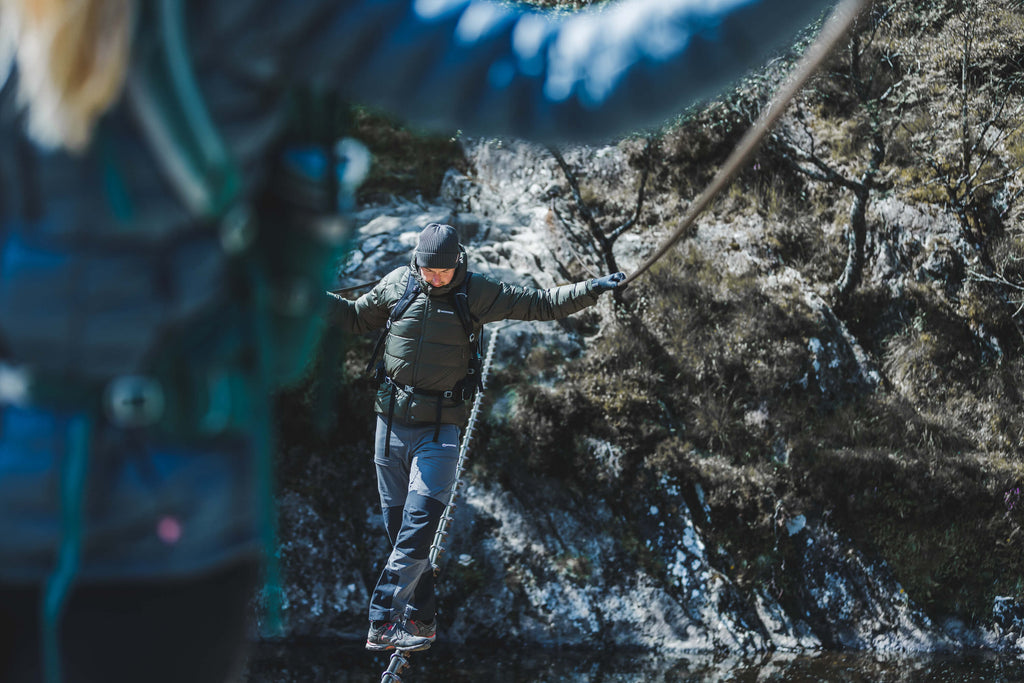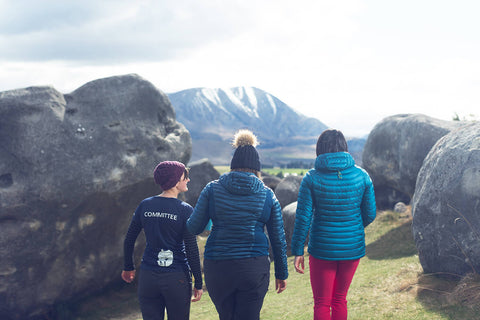Synthetic vs Down: Which one is best?

The short answer is there is no 'best.' They're just a little different.
Down and synthetic each have their good points depending on what adventure you have in mind, how big your budget is, and how light and warm you need to be.
It's a big topic, but we're going to put most of it to the side (I'll put some links through the post if you want to read more) and go through the main practical reasons you would choose one over the other. You can apply this information to jackets and sleeping bags, as the information crosses over. Yay!
Synthetic is better in the wet.
When it comes to torrential rain, synthetic bags and jackets will be better than down, even if the down has an added water-resistant coating (See HyperDRY or the newest innovation ExpeDRY for more info on this). As a side note, some down jackets even have water-resistant fabrics like Pertex to offer an extra layer of waterproof protection!

If down gets wet (we're talking submerged or consistent rain - Pertex fabrics + down will deal with light rain very well), it loses all of its loft and insulating properties.
How down works is that it traps pockets of air between the down and uses this to trap your body heat to keep you warm - nifty, huh? But when it gets wet, down squishes, meaning there is no more space for the down to trap air pockets, meaning it can't insulate and keep you warm. You want a fully lofted, puffy down jacket, not a limp un-lofty jacket.
Synthetic fibers still insulate when wet, as they don't loft. Synthetic jackets and sleeping bags are also easier to clean than down as they don't need to be "relofted" when they get wet (which can mean putting down in the dryer with some tennis balls or fluffing by hand). Just a note here - it's best to avoid getting your down dirty and sweaty, because every time you wash it you lose a little bit of that floof you need. Synthetic fabric is best for kids sleeping bags when they could have accidents at night - as it also dries quickly.
If you already have down and want to know how to clean it, check out our blog here: How to care for your down jackets and sleeping bags.

Down can fit into smaller spaces and is lighter.
Because down has the "lofting" ability we talked about above, it can compress down into small spaces, while synthetic fibers don't compress nearly as well.
And now for some technical talk about measuring down "fill."
Down works on a "fill power rating" system ranging from 300ish to around 900 fill; this rating measures the loft (or fluffiness) of down. This fill power rating is tested by adding a weight of down to a cylinder (the weights and cylinder size vary, depending on where you are) and then adding a weight to compress the down. After a minute, the weight is removed, and the cubic inch of the down is measured. This volume becomes the fill power (900 cubic inch of down is a 900-fill jacket). Higher fill power means it takes less down to achieve a higher temperature rating, meaning it'll be lighter and keep you warmer. You can get jackets and sleeping bags with the same temperature rating but a different fill power - which means a difference in weight, how much it compresses and quality of the down.

Synthetic is cheaper.
If you are a budget wizard, synthetic jackets and sleeping bags are, on the whole, going to be cheaper. It can be man-made on demand, whereas down comes from a duck or a goose. All the down Further Faster sells come with an RDS (Responsible Down Standard), so you know that the birds your down comes from have been treated in a humane way.
What about Enironmental impact?
If you're like me, this is something that you have been more interested in, be that from curiosity or because you want to be more ecofriendly. Either way, it's not a clear black-and-white good or bad answer.
Down comes as a by-product of meat production from goose or duck, meaning that it doesn't go to waste and an already available resource isn't being wasted.
It will biodegrade over time and duck/goose farming has less environmental impact than some other animal farming (it still has an impact though).
And if cared for well, a down sleeping bag or jacket will last a long time.
Whereas synthetic fibers are petroleum-based, the production of the threads and the way they are disposed of both impact the environment. Some companies are using recycled plastics like plastic bottles to create fibers and Primaloft are working to reduce emissions in the production process and have created a biodegradable synthetic fiber. It pays to mention here that washing synthetic products can put harmful microplastics into waterways, but you can get washing bags to put your synthetics in that catch the microplastics, or even filters you can attach straight to your washing machine!
But synthetic fibers are animal free.
It really comes down to your own values here, and what's important to you.
With sleeping bags, use a sleeping bag liner no matter if you go down or synthetic, because it saves having to wash your sleeping bag a lot.
And for clothing and your layering system here's a really great idea from Matteo: "I tend to use synthetic insulation as a mid-layer if it's cold but I'm moving as it deals with the moisture and it getting dirty etc. I normally always have a down layer in a drybag in my pack as it's very light and compact for its warmth, and this comes out when I stop for a break, get to camp or if it's very cold."
And there you have it! Those are some of the main differences between synthetic fibers and down.
I tried to make this post as un-biased and short as I could without leaving out too much information, but there is so much information out there if you want to read more or come into Further Faster and we are more than happy to talk you through some of the options for both down and synthetic products we have 😃
Written by Kirsty Middleton, who now knows a lot about how down works and practically lives in her down jacket.

Top 5 facts for choosing between down and synthetic:
1. Synthetic fibers are better at insulating when wet, although some down is treated to make it more water resistant and is teamed with waterproof fabric - especially on jackets.
2. Synthetic products are easier to clean, down is not impossible to clean, you just have to take more care and it's more involved.
3. Down can compress down a lot more than synthetic fibers, which means it can fit into small spaces more easily.
4. Down is better when it comes to weight vs warmth. You will get more warmth from less weight than with synthetic.
5. Synthetic products tend to be less expensive.
Woo hoo! You made it this far! If you're looking for more reading, try this blog: Quick and Easy Tips for Repairing Gear.










Leave a comment